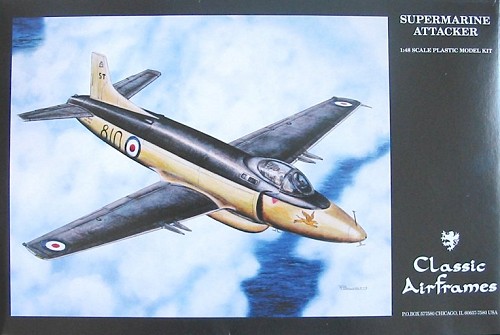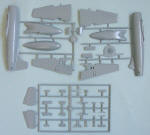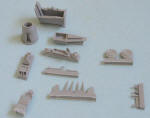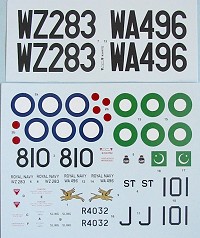
| KIT: | Classic Airframes 1/48 Supermarine Attacker |
| KIT #: | 4102 |
| PRICE: | $54.95 MSRP |
| DECALS: | Three options |
| REVIEWER: | Tom Cleaver |
| NOTES: | Short run with resin parts |

| HISTORY |
The Supermarine Attacker - the first jet fighter in squadron service with the Fleet Air Arm - is a study in the official procrastination that seemed to dominate the British aviation industry in the years immediately following the end of the Second World War. In regards to performance, the Attacker was closely similar to the Grumman F9F Panther, both being powered by the Rolls‑Royce Nene jet engine. Yet the Attacker, which first flew in prototype form two years before the Panther, was destined to enter service three years later than the American fighter.
In 1944, after Rolls‑Royce began work on what would become the Nene ‑ a centrifugal‑flow jet of considerably more power than was shown by the Power Jets Welland or the Rolls‑Royce Derwent developed from the Welland ‑ Supermarine responded to specification E.1/44 with an airplane that used the laminar wings of the company's piston‑engined Spiteful, a development of the Spitfire that would fly in prototype form on June 30, 1944.
After inspection of the wooden mockup, an order for three prototypes to specification E10/44 was issued August 5, 1944; on September 9, and amendment to the contract specified the semi‑ navalization of the second and third prototypes.
Unfortunately, the first Spiteful was lost in the same month, after having demonstrated that the characteristics of the new laminar wing at low speed were undesirable; this poor handling in landing configuration was confirmed by the second Spiteful, which flew in January 1945. In spite of this, a contract for 24 Type 392 jet fighters was confirmed on July 7, 1945. By that November, Supermarine's continuing inability to resolve the low speed handling problems of the Spiteful finally came to the attention of their Lordships of the Admiralty, and it was decided the order for the 24 airplanes was premature; the contract was canceled with the Admiralty requesting that further development of the shipboard fighter be suspended.
Work on the three prototypes continued, with the first one flying on July 27, 1946. The major complaint was in regard to the outdated tailwheel landing gear Supermarine had retained, which led to severe airfield erosion during taxying. A Martin‑ Baker Mk.1 ejection seat was fitted to the second aircraft, which finally flew June 17, 1947; it was the first to be named "Attacker." During carrier trials with this airplane in October 1947, famed British test pilot Eric Brown developed the constant-power/constant-angle approach that is used to this day in landing jet aircraft aboard ship. On February 26, 1948, pilot Mike Lithgow captured the 100‑km International Closed Course Speed Record with the first prototype, averaging 560.634 mph.
In November 1948, in the face of a changing international situation as the Cold War began to develop, the Royal Navy ordered 60 Attacker F.1s. Following this British order, the Pakistani Air Force ordered 36 de‑navalized Attackers able to carry two 1,000‑lb bombs and 8 rocket projectiles. The Royal Navy F.Mk.1, which first appeared May 4, 1950, had no provision for underwing ordnance; No. 800 Squadron FAA was formed with eight Attackers on August 17, 1951, with 803 Squadron following that November. After 43 F.Mk.1s were completed, 16 following were completed as interim fighter‑bombers under the designation F.B.Mk.1.
The definitive Attacker, the F.B.Mk.2, was powered by a Nene 102, and introduced a metal‑framed canopy after two failures of the earlier bubble canopy. This airplane had the same underwing ordnance capability as the Pakistani Attackers. 84 were delivered, with the last one produced a few weeks before the Attacker was removed from front line service.
800 Squadron, with 12 F.B.2s, went aboard the newly‑ commissioned HMS "Eagle" on March 4, 1952. 803 Squadron joined 800 shortly thereafter. After work‑up, the ship departed for the Mediterranean, with the Attackers finally going to sea operationally. The airplane was already obsolete, and upon return from the cruise, 800 Squadron was disembarked for disbandment on May 26, 1954. 803 Squadron returned from Hal Far, Malta, aboard Eagle on June 6, and disbanded at the end of the month. The Attacker remained in service with RNVR squadrons until the end of 1956.
While the Attacker did introduce the Fleet Air Arm to jet aircraft operation aboard ship, it had never been brought up to a satisfactory standard. Its altitude performance was poor, it lacked maneuverability, and it was too unstable to be an effective gun platform. As Eric Brown said of it, "the Attacker marked the beginning of the end of the charisma surrounding the Supermarine name."
| THE KIT |
 The only other 1/48 kit of the Attacker released is a very good vacuform
from Falcon Models, that appeared in the late 1980s and is still available.
The only other 1/48 kit of the Attacker released is a very good vacuform
from Falcon Models, that appeared in the late 1980s and is still available.
 This kit from Classic Airframes continues their line of first-generation
British jet airplanes. The injection-molded parts are very smooth and
shiny, though the engraved panel detail looks a bit heavy. There is an
interesting construction methodology, with the nose being separate from the
main fuselage in order to create the intakes to the Nene engine. The
cannons are done in resin and are separate from the wing, which also
includes separate flaps. The cockpit is in resin and looks accurate - most
of its detail will not be seen due to the fact the cockpit is black.
This kit from Classic Airframes continues their line of first-generation
British jet airplanes. The injection-molded parts are very smooth and
shiny, though the engraved panel detail looks a bit heavy. There is an
interesting construction methodology, with the nose being separate from the
main fuselage in order to create the intakes to the Nene engine. The
cannons are done in resin and are separate from the wing, which also
includes separate flaps. The cockpit is in resin and looks accurate - most
of its detail will not be seen due to the fact the cockpit is black.
 Decals are provided for three airplanes - an F.Mk.1 of 800 Squadron, an
F.B.Mk.2 of 1831 Squadron RNVR, and a Pakistani Attacker. While the serial
number of the F.1 is in the range for F.1s, no F.1s were aboard HMS “Eagle”
in 1953, since the F.B.Mk.2 had replaced them. A modeler would be on
stronger ground using the serials for the 1831 Squadron airplane with the
markings for 800 Squadron to get an F.B.Mk.2 used operationally.
Decals are provided for three airplanes - an F.Mk.1 of 800 Squadron, an
F.B.Mk.2 of 1831 Squadron RNVR, and a Pakistani Attacker. While the serial
number of the F.1 is in the range for F.1s, no F.1s were aboard HMS “Eagle”
in 1953, since the F.B.Mk.2 had replaced them. A modeler would be on
stronger ground using the serials for the 1831 Squadron airplane with the
markings for 800 Squadron to get an F.B.Mk.2 used operationally.
The one thing that fails in the kit is the one thing that has failed in their Meteors and Vampires - the canopy. The canopy is thick, and not correctly shaped (the same problem the other kits have). The canopy in my review sample is additionally marred by flow marks clearly visible in it, which are unlikely to go away even after a dipping in Future. I have spoken to other modelers who have found the same problem, so this is not some passing anomaly. Fortunately, since I never throw parts away, I still have the “extra” excellent Falcon vacuform canopy that came with the vacuform kit I built a few years back, and I will be using that on this kit.
Editorial rant follows:
I really, really wish Classic Airframes would go back to using their excellent vacuform canopies, which were thin and clear and accurately shaped. Some modelers claim to have problems with vacuform canopies, but I have been using them for 30+ years now, and anyone with the hand-eye coordination to touch their nose with their index finger on successive attempts can learn the really minor skills necessary to use these successfully. (Your editor is obviously one of these people who cannot perform this rather dexterous task. Ed) They vastly improve the kits and get rid of the one problem in the box.
| CONCLUSIONS |
This kit of the Attacker looks to be dimensionally accurate and also to correctly present the bulbous shape of the forward fuselage. I think the heavy surface detail will look all right under a few coats of paint. For those modelers who like first-generation jets, the Attacker - one of only two taildragger jets to see operational service (the other being the Yak-15) - is an interesting airplane that will look attractive in its early-50s Fleet Air Arm camouflage. Try and get hold of a Falcon canopy if you can.
October 2005
Review kit courtesy of Hannant’s - http://www.hannants.co.uk
If you would like your product reviewed fairly and quickly by a site that has around 300,000 visitors a month, please contact me or see other details in the Note to Contributors.